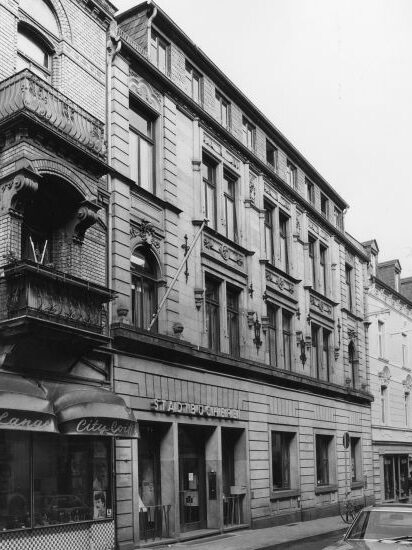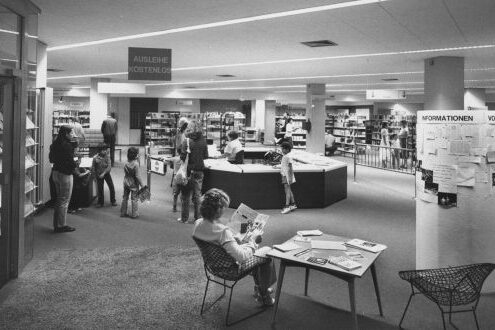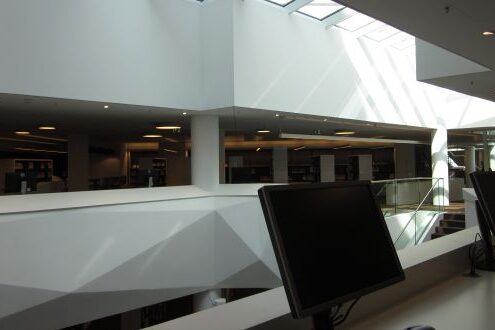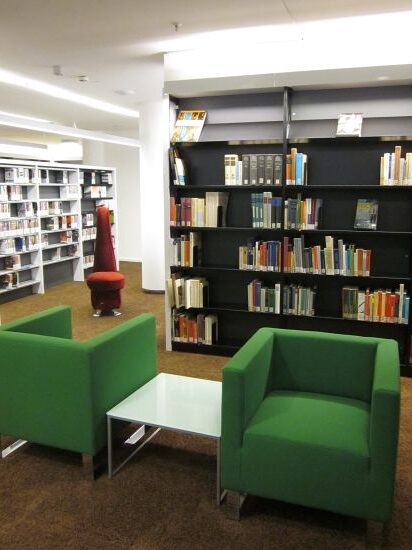Wiesbaden City Libraries
The city libraries date back to the Wiesbaden Public Education Association founded in 1872. Today they include the central and music libraries, six district libraries and the mobile library with two buses. Around 1.2 million books and media are borrowed every year.
The city libraries of the state capital of Wiesbaden look back on a long history. Its roots can be traced back to 1805, when court bookseller Ernst Ludwig (Louis) Theodor Schellenberg set up a reading museum in the Schützenhof. In 1872, at a time of economic and cultural prosperity, the actual foundation stone for today's municipal library was laid: The Volksbildungsverein Wiesbaden was founded and with it a library that could be used free of charge by members of the association. It was a reference library, meaning that the books could not be borrowed, but only read on site.
In 1934, the municipality took over the lending libraries of the Volksbildungsverein in order to turn them into a "municipal public library". The public library was combined with the newly established "State Advisory Center for Popular Libraries for the Wiesbaden Administrative District". The first municipal library was thus established in Schützenhofstraße. Anyone could use it, but the books were still not freely accessible; instead, a librarian decided on the fulfillment of reading requests.
The years of reconstruction after the Second World War were characterized by a strong decentralization of the municipal library. Even the smallest suburbs with fewer than a thousand inhabitants were given a library branch with a minimal collection.
In 1966, the library moved to Mauritusstraße 13. The larger space was used to completely redesign the library according to the latest standards. Library director Henry Gerster designed an open access library in which the books were arranged thematically and made accessible to readers. The library system, which had grown to 24 branches, was fundamentally restructured, and a modern mobile library with two buses visited the suburbs and replaced the smallest branches.
The 1980s saw the city library move to the Weinandhaus in the Rathauspassage. Library director Karl-Heinz Pröve brought numerous well-known authors to Wiesbaden. In 1986, the "Wiesbaden Literature Days" were launched.
Library director Irene Friedrich-Preuß led the library into the modern age: in the 1990s, IT was introduced into the city libraries and brought a fundamental improvement in service. The library's book collection could now also be accessed from home via the Internet. The premises of all district libraries were successively renovated and refurnished, and the mobile library was given a new concept. Author readings and the "Wiesbadener Literaturtage" were handed over to the Literaturhaus Villa Clementine, the city library concentrated on its core tasks, subjected the book collection to a thorough revision, updated and completely restructured it. New readers were attracted. In 2000, the number of books borrowed exceeded the million mark for the first time.
The importance of promoting reading for children in a modern world of communication was recognized, a concept was developed and implemented in all library facilities. The sustainability of continuous work became a successful method of introducing children, even from educationally disadvantaged backgrounds, to books and reading.
In 2001, the Wiesbaden City Library was awarded the "Hessian Library Prize" of the Sparkassen-Kulturstiftung Hessen-Thüringen, endowed with €10,000, for its concept of "mobile primary school provision".
The new millennium brought new challenges. The Internet and W-LAN have found their way into library rooms that used to be home to card catalogs and folios. What significance can a library still have in the age of Google and Wikipedia? The library as a place has gained in importance: school groups learn together here, the 70+ generation uses the internet.
At the beginning of 2010, 375,000 books and modern media were spread across the central library in the city center, the music library on Schillerplatz, the mobile library with two buses, integrated into the Biebrich district library, as well as six other district libraries in Bierstadt, Freudenberg, Klarenthal, Mainz-Kastel, Mainz-Kostheim and Schierstein. In 2010, the city library became a member of the Onleiheverbund Hessen. Since then, visitors have also been able to download an extensive range of media free of charge. The libraries are open to the public for a total of around 240 hours per week. Around 1.2 million books and media are borrowed every year.
In spring 2014, the Central Library, together with the Music Library and the Media Center, moved into its new premises in the Mauritius Mediathek in Hochstättenstraße. The premises, designed by architects Lengfeld+Wilisch in Darmstadt, integrate the library services into a high-quality interior with a high quality of stay. The architectural design language quotes precious folded paper on the balustrades, stairs and service counters.
The large room is repeatedly interrupted and has a quiet, manageable, very personal atmosphere. Modern communication facilities such as Sonic Chairs, Internet access, laptops and an open Wi-Fi network complement the library's services. Another new feature is RFID technology with self-checkout and self-return devices, even outside opening hours, combined with a book sorting system
Literature
The Wiesbaden Public Education Association. Library education work in the German Empire and the Weimar period. Schriften des Stadtarchivs Wiesbaden Vol. 6, Wiesbaden 1997.



